The Maju Expressway (MEX) (formerly known as Kuala Lumpur–Putrajaya Expressway(KLPE) and KL–KLIA Dedicated Expressway) Maju Expressway (Malay: Lebuhraya Kuala Lumpur-Putrajaya) is an expressway network in Klang Valley, Malaysia. The 26 km (16 mi)-long expressway links the Kuala Lumpur City Centre with the Kuala Lumpur International Airport (KLIA) in Sepang, Selangor. The expressway is a backbone of the Multimedia Super Corridor (MSC) area.

The Kuala Lumpur City Hall is the city council which administers the city of Kuala Lumpur in Malaysia. This council was established after the city was officially granted city status on 1 February 1972. Their jurisdiction covers an area of 243 square kilometres.

Puchong is a major town and a parliamentary constituency in Petaling District, Selangor, Malaysia.

Wangsa Maju is a township and a constituency in Kuala Lumpur, Malaysia. This area is surrounded by Setapak, Taman Melati and Gombak district in Selangor. Wangsa Maju is one of the major suburbs in Kuala Lumpur.

Setapak is a mukim in Gombak District, Kuala Lumpur, Malaysia. Formerly a tin-mining and rubber estate area, in Malay tapak means 'step' so Setapak means 'one step', probably referring to the close proximity of the suburb to Kuala Lumpur. Another explanation of the origin of its name traces to its historical roots.

Kepong is a town in northern Kuala Lumpur, Malaysia. The name is a Malay word meaning "Enclose" or "Surround", as the town is surrounded by a mountain range.
Jalan Ampang or Ampang Road is a major road in the Klang Valley region, Selangor and the Federal Territory of Kuala Lumpur, Malaysia. Built in the 1880s, it is one of the oldest roads in the Klang Valley. It is a main road to Ampang Jaya and is easily accessible from Jalan Tun Razak or Jalan Ulu Klang from the Hulu Kelang or Setapak direction. It is also accessible from Cheras through Jalan Shamelin, from Jalan Tun Razak through Jalan Kampung Pandan via Taman Cempaka, from Kampung Pandan through Jalan Kampung Pandan Dalam via Taman Nirwana, from the Kuala Lumpur Middle Ring Road 2 via Pandan Indah and Taman Kencana and from Hulu Langat town through the mountain pass. Wangsa Maju, Setapak, central Kuala Lumpur, Ampang Park and Salak South surround Ampang. Jalan Ampang became the backbone of the road system linking Ampang to Kuala Lumpur before being surpassed by the Ampang–Kuala Lumpur Elevated Highway (AKLEH) in 2001.
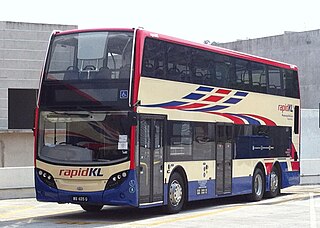
Rapid Bus Sdn Bhd is the largest bus operator in Malaysia operating mainly in urban areas of Klang Valley, Penang & Kuantan. As of February 2023, Rapid KL service brands unit of Rapid Bus, has operates 113 normal routes and also 69 MRT Feeder Bus routes, along with 8 Nadiputra routes in Putrajaya.
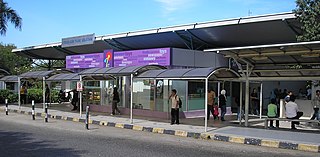
Bandar Tasik Selatan station (BTS) is a major Malaysian interchange station located next to and named after Bandar Tasik Selatan, in Kuala Lumpur. The station serves as both a stop and an interchange for the KTM Komuter's Seremban Line, KTM ETS, the LRT Sri Petaling Line, and the Express Rail Link's KLIA Transit trains. BTS is integrated with the Terminal Bersepadu Selatan bus hub (TBS). BTS and TBS are developed as an intermodal transportation hub.
Transport in Greater Kuala Lumpur includes a road network, a railway network, airports, and other modes of public transport. Greater Kuala Lumpur is conterminous with the Klang Valley, an urban conglomeration consisting of the city of Kuala Lumpur, as well as surrounding towns and cities in the state of Selangor. The Klang Valley has the country's largest airport, the Kuala Lumpur International Airport (KLIA), as well as the country's largest intermodal transport hub and railway station, Kuala Lumpur Sentral.

Wangsa Maju LRT station is an elevated rapid transit station in Wangsa Maju, Kuala Lumpur, Malaysia, forming part of the Kelana Jaya Line. The station opened on June 1, 1999, as part of the line's second segment encompassing 12 stations between Kelana Jaya station and Terminal PUTRA and an underground line.
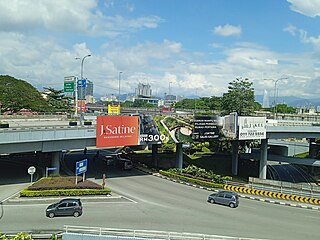
The Genting Klang–Pahang Highway or officially Jalan Genting Klang and Jalan Pahang, as it is locally known, is a major highway in Kuala Lumpur, Malaysia.
Taman Ibukota is a Malay majority township in Setapak, Kuala Lumpur, Malaysia. It is a large and rather old neighborhood dating back to the 1970s when Kuala Lumpur City Hall (DBKL) workers were given discounted rates to purchase the houses there.

Jalan Ipoh is a major road in Kuala Lumpur, Malaysia. The road is named after the city of Ipoh in Perak. Its English name is called Ipoh Road.
Taman Melati is a Malay majority township in Wangsa Maju, Kuala Lumpur, Malaysia. It is located between Gombak, Klang Gates, Wangsa Maju city centre and Taman Melawati. The 5 Kelana Jaya Line's KJ2 Taman Melati LRT station is situated in this area.

The BRT Federal Line was a proposed bus rapid transit for Kuala Lumpur–Klang Corridors, and it has been identified in the KL BRT Report 2011 as one of the potential BRT Corridors in the Klang Valley region. The BRT project was planned to be operational by 2018, but is now shelved indefinitely. The government cited "redundancies with the LRT3 " as the reason for its decision to cancel the project.

Setapak Central, previously known as KL Festival City, is a shopping mall located along Jalan Genting Klang in Kuala Lumpur, Malaysia. It is situated in Danau Kota, a township in Setapak.
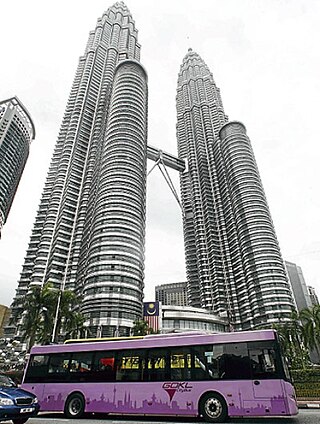
Go KL City Bus is a free bus service in the city centre of Kuala Lumpur, Malaysia. Previously managed by Land Public Transport Commission (SPAD), the services were taken over by Kuala Lumpur City Hall (DBKL) by 1 January 2019.
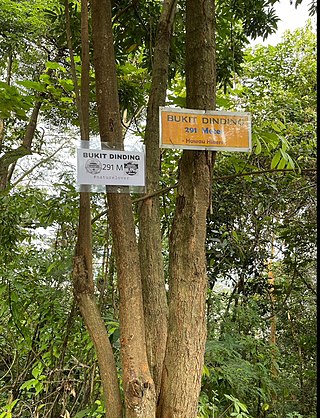
Bukit Dinding is a forested hill with published height of 291m in Kuala Lumpur sitting in between Setiawangsa and Wangsa Maju. There are variation of heights in different records where according to Google Earth (2022), the height of Bukit Dinding is 302m, but according to Kuala Lumpur Slope Information System (KULSIS), it is 311m.




















